Farm borrowing advice in a cautious economic climate
 © Tim Scrivener
© Tim Scrivener The 0.5 percentage point rise in the bank base rate to 4% last week adds £5,000 to the cost of every £1m of UK farm borrowing on variable rates.
Bank of England figures for December 2022 show the amount outstanding to farming and forestry at £18.046bn, which is slightly lower than the final figure for the previous year.
“It feels as if the banks are a bit more cautious as a result of problems in the wider economy, consumer buying habits, commodity and input volatility,” says Greg Ricketts, rural director at northern farm consultant GSC Grays.
See also: Grain futures and options can help manage risk
“They are looking for more management information and want to know what the baseline is, how low cost of production is, and how good a handle farmers have on this.
“They want farmers to understand sensitivity and stress-test their budgets.”
In November 2022, Mr Ricketts submitted a proposal using a 42p/litre milk price to two different banks. Both banks came back wanting the numbers run at 40p/litre.
The most recent milk price cuts have been quicker and deeper than many expected and underlines how fundamental that cost-of-production knowledge and sensitivity analysis are, he says.
Most farms are paying 2.5-3.5 points over base for their overdrafts, with exceptions at 2.25 for larger and very well run businesses, say advisers. Recently agreed loans are at similar margins.
Service levels
Lending thresholds tightened following the 2008 economic crash, and the Covid-19 pandemic has left many high street banks understaffed.
Some have changed to a hub system of service, so that rather than having a dedicated agricultural manager, a farming customer might speak to a different member of the team each time they call.
This can be frustrating and can disjoint the relationship, says Mr Ricketts.
Accountant Rob Hitch of Dodd and Co, based in Cumbria, sees the same trends, with most banks struggling for staff.
“Farming is capital intensive and doesn’t fit the lending criteria that most banks have,” he says.
“They are small businesses but they borrow quite a lot. Unless you are borrowing £0.5m-plus, you are unlikely to get a dedicated manager,” he says.
All the banks still want to lend to farming, but they are becoming more choosy about their exposure, keen to lend to some sectors but noticeably pulling back from others, says Mr Hitch.
“Things are getting a bit tighter, they are all looking for businesses that generate cash.”
Some of the newer arrivals in the agricultural banking market have shorter management chains and so can make quicker decisions, he says.
Both advisers warn to consider the length of loan terms carefully.
While it’s positive to think of being able to repay a loan over, say, 10 years, farming businesses often go for too short a loan term, which can put unnecessary pressure on the business, they say.

© Peter/Adobe Stock
Covenants
However, many long-terms loans are subject to review at five-yearly intervals, with covenants making continued access to borrowing dependent on a business meeting financial performance targets.
Because of this, most loan terms are just five years in practice, says Mr Hitch.
Advisers stress the importance of understanding what has been signed up to and monitoring performance so that if it looks as if a breach is likely, this can be flagged to the bank and a plan put in place to address it.
“We’re also seeing a bit more effort put into monitoring and checking monthly performance for some businesses. Lenders want to see interest and loan repayments covered out of cash,” says Mr Hitch.
Borrowers need to understand what they are signing up to, he warns, as some covenant terms do not make good business sense.
For example, one standard term penalises businesses for making capital investments out of cash, recording this as a drop in the performance of the business.
In fact, it could be shown as a positive because that investment will improve business performance.
“Borrowers need to understand what the covenant is trying to measure. More people should have their loan documents checked over. We have just a handful of people who have brought them to us before signing, ” he says.
Charges
Published overdraft renewal fees are 1%-plus of the facility but, in practice, farmer customers tend to pay 1%, says advisers.
With overdrafts subject to this annual fee, it’s important to consider how much is needed, so that the fee is only charged on a relevant sum.
Agreements
Banks are increasingly likely to want to see a well-drafted partnership agreement before offering facilities.
They will want to be assured that those joining the business are competent and that the agreement caters for the death, incapacity or retirement of a partner without the partnership having to be dissolved.
Borrowing tips
- Past performance is not a guide to future performance – one year in five or two years in 10 might produce a loss. Account for this so that in the poor years, borrowing commitments can still be funded
- Assess the extent of loan commitments – total everything including hire purchase and remember that the capital element of loans has to be paid out of profit after tax
- Allow for tax in cashflows
- Overdraft questions – is the limit realistic? Is there a core that should be put on a loan to inject some repayment discipline? Conversely, is the 1% renewal fee covering an element of the facility that is unlikely to be needed?
- Fully understand the real requirements for profit from the business – profit before depreciation needs to be sufficient to cover loan and hire purchase capital repayments, private drawings, tax, reinvestment and risk
- Bank credit teams will want to see budgets, management accounts, and to know that you are monitoring performance against budget and have put some sensitivity into budgets to account for volatility
- Read and understand covenants where these are a condition of the loan – if they are not clear, have them checked by an adviser
- Loan lengths – don’t be overambitious by going for a loan term that is too short for the project or asset
New land uses and borrowings
Undertaking biodiversity net gain offsetting agreements and other long-term land use arrangements will have an as-yet-unknown effect on the value of land and, therefore, on a lender’s security.
Such agreements often mean introducing a third-party interest in the land, which must be notified to the lender if the land has been used as security for a loan.
“If the loan to value is high, and it’s going to be a significant commitment, then there could be concerns,” says Mr Ricketts.
“It depends on the proportion of the farm [under the agreement] – if it’s 10% it might not be such a concern.”
